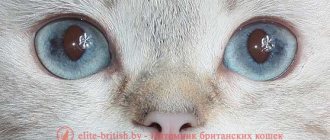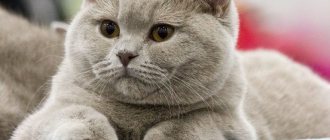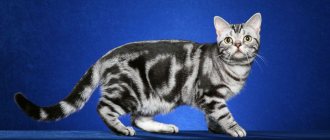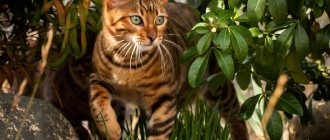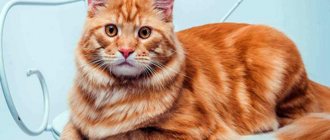Main characteristics common to all types of Abyssinian color
If you look closely at the fur of an Abyssinian cat, you will notice that on each of its hairs the dark color gives way to light.
Attention : in the standard color, one hair of an Abyssinian cat must have at least three stripes.
In standard colors, Abyssinians do not have a clearly defined pattern on their fur coat. The hair of this breed is short and close to the body. The undercoat is always several shades lighter than the main color.
Abyssinian cat colors according to international standards, the main characteristics include:
- dark stripe on the back and tail;
- necklace in the neck area;
- absence of a pronounced pattern on the head (except for the blue color).
Appearance of the Abyssinian cat
The Abyssinian blue cat is flexible and muscular. The long, slender limbs allow the animals to reach distances that are six times their body length. Males are slightly larger than females. The weight is the same for everyone - 3-4.5 kg. The Blue Abyssinian is harmoniously built and graceful.
Head, eyes, ears, neck
The dimensions of the wedge-shaped head are proportional to the body. The cheekbones are smoothed, the back of the head smoothly flows into the neck. The bridge of the nose is straight, the stop is smooth. The chin is rounded, the muzzle is graphic. Males have pronounced cheeks.
Expressive almond-shaped eyes are set wide at a slight angle. The breed standard does not allow an oriental or rounded cut. The eyes are sparkling, amber, copper or green, as if lined with a black pencil. Blue cats have green irises. The halo is thin, light, matching the undercoat.
The ears are large, set wide and slightly inclined. The ears are wider at the base, narrowing and rounded closer to the tips. The inner surface of the ears is covered with vellus fur, in the center there is a bald spot, as if from a thumb. Funny woolen brushes stick out of the ears.
The neck is elongated, thin and graceful.
Body, limbs, paws, tail, fur
The body is elongated, flexible, harmoniously folded. The chest is rounded, there is a slight deflection on the back.
The limbs are long, thin, strong. The paws are large, oval, the toes are small, pressed tightly against each other.
The tail is long, thick at the base, narrowed at the end.
The coat is short, thick, soft and silky to the touch, and tickles in the sun. The hairs on the back are longer than on the body.
Colors of Abyssinian cats included in the breed standard
In total, there are only 4 colors of Abyssinians, which are accepted by the world Association.
Important : adult Abyssinians reach maximum hair coloring at the age of one and a half years, after the first spring molt.
Classic wild
Initially, this was the only standard color of the Abyssinian. It is still in greatest demand today and is considered the most widespread. The classic shade combines rich brown and black tones.
Abyssinian cats of classic wild colors have:
- uniform ticking of 3 segments;
- dark brown color of the back and sides, in contrast to the lower part of the body;
- dark brown paws;
- black stripe on the back;
- a clearly defined nose of reddish-red (brick) color.
Please note : all Abyssinian kittens are born with blue eyes. And at 10 months of age they change their color.
Blue
This color became standard quite recently. The coat of the Blue Abyssinian is gray-beige with a pronounced silver tint. The main requirements for this color are:
- presence of a pattern on the muzzle;
- light beige tone of fur on the belly and chin;
- a small stripe along the back with a pronounced blue color;
- brick-colored nose with a clearly defined contour;
- lighter shade of undercoat, but not white.
Faun
This color is quite rare among Abyssinians. Outwardly, it is similar to sorrel, but not as rich and pronounced. The Abyssinian faun looks very noble and elegant.
Peculiarities of coat color in different types of Abyssinian cats
There have been few changes in color in the century since the breed was first described in 1889. To the starting standard, compiled by the author of a whole list of works on animals, G. Steils, several color variations of the color of the Abyssinian coat, obtained through selection, were added, and the original range of coat became warmer.
Color of individual types of Abyssinian cat
Of the four colors officially listed in the international standard for the Abyssinian breed, the most common color is ruddy, or "wild". It is characterized by the presence of such shades as: - chocolate brown, almost black; - dark brown with a noticeable orange tint; — ocher of different saturations.
Abyssinians with this coloration most of all inherited similarities with their African ancestors - reed wild cats. All shades of coat are classified as dark brown, not turning into black, dark ocher with many nuances of this color. The ruddy may have small black markings on the tip of its tail and muzzle.
The other three main colors of the breed are:
1. Sorrel (sometimes spelled sorel), or red, by definition somewhat brighter than ruddy. Because of the reddish, dark orange, golden brown, brick shades, this color is sometimes called after the breed of horse - bay. Russet Abyssinians have chocolate and brown markings on their face and tail.
2. The color of the Abyssinian fawn is calmer. These are beige or pinkish-beige, light fawn colors. The ticking on the fur is less pronounced, but it is this subspecies that corresponds to the epithet “sunny cat” more than its relatives.
3. The blue Abyssinian cat with the epithet “aleurite” wears a fur coat of gray-blue shades. The body has silver-gray, less often warm beige, fur. There are bright slate gray markings on the tail and muzzle. This variety, like the fawn, is not common. A professional table for mating Abyssinians helps preserve silver wool, which takes into account the types of genes and the dominant ones among them.
Peculiarities of inheritance of hair coloring in Abyssinian kittens
It is noteworthy that from parents with different colors, kittens are not given mixed coat colors, but always one whole coat. In color, the ancestor whose genes turned out to be dominant “wins.” It may be eumelanin (black) or pheomelanin (yellow-red).
Blue Abyssinians and fauns appear when mating those pairs of Abyssinians who have a stable lightening gene. To get silver kittens, it is not enough to see the exterior of the female and the male, especially if the partner for mating is selected from a photograph. The pedigree of each parent is required to at least the fifth generation.
Since the gene for white wool does not exist at all in a pure breed, mestizos are easily identified, in which, if not legs and a neck with stripes, then a white “shirt-front” or light “socks” with dark splashes are visually visible. Spotted (leopard) or striped coloring on purebred animals is unacceptable. The Fawn and Blue breeds do not have a white undercoat by standard.
Colors that are not included in the standard
In addition to the four main colors included in the breed standard, there are other colors of cats.
Black
The black Abyssinian looks elegant and impressive. Despite the fact that such cats are not included in the standard, they are very popular among people. Their fur is dark chocolate or black and gray in color, and their belly can be brown or gray. But black Abyssinians are quite rare. Since they are difficult to obtain by breeding.
White
Abyssinians can get white color:
- under the influence of the recessive albinism gene. In this case, a white kitten with blue eyes is born;
- with large white spots. As a result, the cat is not completely white, but it is dominant;
- with a dominant white color. In this case, the white gene (W) is completely dominant.
Chocolate
This is one of the most common colors, despite the fact that it is considered unrecognized. The base of the fur of chocolate cats is golden or copper, smoothly turning into apricot, and then into dark chocolate color. Paws are plain and brown.
Lilac
The fur of the Lilac Abyssinian has a soft, warm gray tone. And the purple effect itself is formed due to the ticked tone of the hairs. At the base of the coat there are creamy pink or soft cream hairs that smoothly turn into gray. Abyssinians of lilac colors always have pale pink nose and paw pads.
Silver
Gray Abyssinians are characterized by a ticked coat, characterized by a subtle transition from silver to blacker. At the base, the hairs have a gray tint, which then turns into a shiny steel tint. And the tips of the fur themselves are darker and almost black.
The paws of Abyssinians are silver and have a solid black color. The color of the nose can vary from dark pink to red. It depends on the main rich color of the cat. Quite often, silver Abyssinians are born with defects: spots or stripes on their coat. But this does not matter to the owners, since they are not included in the breed standards anyway.
Abyssinian cats of fawn color and their features
Like other shades in this breed, the fawn has a zonal color scheme. This means that the coloring of each hair has a combination of dark and light shades of the same color. They alternate, creating an overflow effect. It looks very attractive on the animal’s fur; literally, when moving, the fur shines and shines.
Color
The smooth fur coat has two shades. At the top of the back there is a wide, darker stripe of peach color. The inside of the body, belly, paws and chest are painted in a very light, creamy color.
Important! The paw pads are usually pink, as is the animal's nose. The eyes of such representatives of the breed are bright orange or amber.
This kind of ticking is very rare. Representatives of the breed are born with a similar color due to the activity of a recessive gene, which is responsible for lightening the base color. Thus, animals of the fawn color are the same Abyssinians of the Sorel color, but greatly bleached due to a change in the gene chain.
Most often, cats with a fawn coat shade are born male. It is even more rare to meet a female with a similar shade of fur in a litter. To achieve the desired color, breeders cross one animal with a fawn coat color and a second animal that bears the desired shade.
Character
All Abyssinians have a very friendly and easy-going disposition. They have a natural curiosity and can be a little mischievous at home, climbing on high surfaces of cabinets, shelves and other pieces of furniture. They often fall from there and touch other decorative parts.
Cats love to spend time with their owner. At the same time, they will not quietly lie in front of the TV, waiting for attention to their person. Abyssinians need to be played and active. That is why the breed is not recommended for people who tend to lie in front of the TV in the evenings.
Undesirable color deviations
The Abyssinian breed has certain standard colors that appear at the age of 4 months. And at first, the kittens’ coat is fluffy and has an inexpressive faded color. As they grow older, the coat becomes more pronounced and fully complies with color standards.
Attention : pronounced patterns on the coat of the Abyssinian are considered a defect. Although, according to international standards, small white spots on the chin and collar are allowed.
The most common color deviations in Abyssinians are:
- different shade of paw pads from the main color of the coat;
- lack of black eyeliner around the eyes;
- the presence of dark spots or patterns on the face;
- lack of a necklace around the neck;
- too bright contrast between the main tone of the coat and the undercoat;
- absence of a dark stripe on the back or tail.
A lighter color of the lower part of the body in the base color is allowed. But the undercoat of purebred Abyssinian cats must exactly match the main color tone, but it can be a little lighter or brighter.
Important : the presence of dull or gray undercoat tones in Abyssinian cats is unacceptable.
What determines the color of the Abyssinian
The unusual and original colors of the Abyssinians are their calling card. This is due to the presence of several genes in their genotype, the dominance of which determines coat color.
Genes responsible for coat color
The following genes are responsible for the coat color of Abyssinians:
- Agouti "Ta" gene. It determines the presence of ticked hairs on the fur;
- "Ttb" gene. With its dominance, kittens are born of a “tiger” color;
- “U” gene. When it is dominant, there is no clear pattern on the coat.
The color of a purebred kitten largely depends on the combination of genes planned by the breeders. Kittens may be born with patterns on their fur that will disappear on their own as they grow older.
Attention: the presence of a gray and faded undercoat on a kitten indicates a crossbreed.
Despite the fact that the presence of white spots on the face, belly, paws and tail is not considered a defect, they try not to use such cats for breeding.
Genes responsible for color tone
Looking at the colors of an Abyssinian cat, you can see that they are formed not only due to their own color, but also due to the tone of this color. That is, the dominant gene in them is the D gene, and its recessive companion is d. Together these genes give a rich dark or lightened color. The dominance of genes is manifested due to their combination:
- a combination of DD or Dd genes produces dark tones;
- the combination of recessive genes dd is responsible for the light color.
In other words, the Abyssinian wild color is obtained through a combination of black color and rich tone. That is, a pair of DD or Dd genes. The Abyssinian blue color is obtained due to the combination of black and light tones, namely the dd genes.
How do eye color and coloring relate?
The eye color of Abyssinian cats directly depends on the main color of their coat:
- Abyssinians of wild colors have eyes of hazel, golden or green;
- The Abyssinian faun cat has eyes that strictly correspond to the standard color. Their color can vary from golden to green;
- The Abyssinian sorrel is most often found with golden or copper eyes. Although green or dark hazel eyes are allowed for this color;
- The blue Abyssinian has golden and copper eyes. Green and nutty shades are less common.
Abyssinian cat fur care
Abyssinian cats are ideal for indoor keeping. They have good health, practically do not shed (thanks to their short hair), are completely unpretentious in food, and do not cause any trouble to their owners.
But they, like any other purebred cats, need to be provided with proper coat care:
- Once or twice a week, your pet must be combed with a special comb with metal teeth;
- During the spring molting period, it is recommended to periodically bathe cats and brush them frequently;
- For bathing Abyssinians of all colors, a special shampoo is used, and the water is changed 2-3 times during the bathing process. This breed loves to swim, but hates showering.
In order for your pet to have perfect fur, it needs to have a proper diet, be given the opportunity to exercise a lot and keep it clean.
In conclusion, it is worth noting that Abyssinian cats are distinguished by: their regal coloring, the arrogant look of their huge expressive eyes, and their nobility. They conquer their owners with obedience, friendliness, affection and warmth. This breed is characterized by loyalty and affection for its owners, and does not tolerate loneliness at all. Therefore, if you are often not at home, it is recommended to get two cats at once, and not necessarily of the same breed. Instead of a cat, you can get any other pet (just not a parrot or rodents), since Abyssinians get along well with all animals and always try to find contact with them.
How to choose a kitten
You need to purchase Abyssinians from reputable breeders or large nurseries with a good reputation. First, it is recommended to get acquainted with the photos of Abyssinians offered for sale.
The kitten must be prepared for sale:
- he must be at least three months old;
- the required vaccinations have been completed;
- the baby must be trained to the tray;
- Weaned from maternal nutrition and transferred to an independent diet.
Important! When purchasing Abyssinian kittens, you need to be aware of the breed's susceptibility to genetic diseases. It is imperative to check with the breeder whether there are genetic tests to detect pathologies in the parents.
The main signs that Abyssinian kittens are healthy:
- They have a playful character, make contact easily, and do not look timid.
- The shiny iridescent fur has no scuffs.
- The gait is confident, the movements are active.
- When palpating the abdomen, there are no hernias or bloating.
- There is no purulent discharge from the eyes or ears.
Important! The breeder must provide a complete package of documents. The pet passport must contain vaccination information. The pedigree must indicate that there were no inbreedings in the breed. Certificates of genetic testing.
Abyssinian kittens photos
2 kittens
3 kittens
with a toy
with a ball
plays
resting
What is this?
yum
tired
I want to sleep
What?
…
1 Week
Cost of the Abyssinian breed
In Russia, the popularity of the Abyssinian cat breed is only increasing and the cost of an Abyssinian cat depends on the class:
- Pet - a simple home companion with the condition of mandatory castration - approximately 15-30 thousand rubles .
- Breeding - healthy kittens with positive tests for the absence of genetic pathologies for further reproduction with the opportunity to be exhibited will cost from 30,000 to 45,000 rubles.
- Show - kittens with a prestigious pedigree and with the right to breed and participate in exhibitions, the price of which can reach from 65,000 to 85,000 rubles.
Important! How much Abyssinian cats cost largely depends on where they were purchased. Selling cheaper animals through advertisements may have the risk of acquiring a genetically diseased pet.
Nurseries
If a potential owner needs an Abyssinian kitten for home, then you can buy it cheaper, but better from breeders or nurseries.
Catteries with positive reviews where Abyssinian kittens are bred:
- Republic of Belarus, Minsk. Nursery, ABYMASCOT, version of the CFA / WCF standard. Contacts: +375292804312.
- Russia, Krasnodar. Nursery BLACK HAZEL, version of the CFA / WCF standard. Contacts.
- Russia Moscow. Nursery Gold Pandora Aby Cattery, CFA / WCF standard version. Contacts: +79999677778.
- Russia, Saint-Petersburg. SILK TASSEL nursery, version of the CFA / WCF standard. Contacts: +79214118010 “Shining By”,






